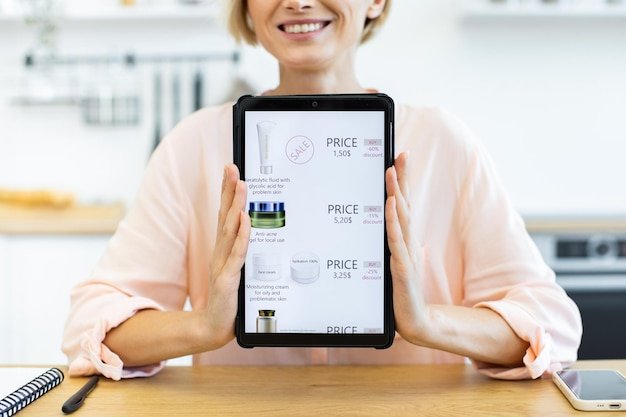Data-Driven Buying Guides: Smart Choices in 2025

Buying Guides: The Data-Driven Approach to Making Smarter Purchase Decisions in 2025 emphasizes leveraging data analytics, AI, and personalization to provide consumers with tailored recommendations, ensuring informed and satisfying purchase decisions.
Navigating the world of purchasing decisions can be overwhelming. In 2025, the game changes with a buying guides: the data-driven approach to making smarter purchase decisions in 2025. This approach empowers consumers with insights, personalization, and informed choices.
The Evolution of Buying Guides
Traditional buying guides are transforming. The shift is toward personalized data-driven experiences, leveraging advanced technologies to offer precise recommendations tailored to individual consumer needs and preferences.
From Print to Pixels: A Historical Overview
Buying guides have transitioned from physical publications to digital platforms. This evolution reflects broader changes in information access and consumer behavior.
- The first buying guides were simple lists of products and their features.
- The internet era brought online platforms with user reviews and comparisons.
- Today’s guides integrate AI, data analytics, and personalized recommendations for enhanced user experience.
This evolution showcases the dynamic nature of consumer information and the ongoing quest for informed purchasing decisions.
The future of buying guides lies in enhanced data analysis, personalized recommendations, and interactive user experiences. This evolution promises more informed and satisfying purchasing decisions for consumers.

Key Technologies Driving Data-Driven Buying Guides
Several key technologies are crucial to the rise of data-driven buying guides. These technologies enable sophisticated analysis, personalized recommendations, and seamless user experiences.
Artificial Intelligence (AI) and Machine Learning (ML)
AI and ML algorithms analyze vast datasets to predict consumer behavior and preferences. These algorithms enable highly personalized recommendations.
Big Data Analytics
Big data analytics processes large volumes of data to identify trends and patterns. This provides invaluable insights for product selection and recommendation.
Personalization Algorithms
Personalization algorithms use individual consumer data to tailor buying guide content. This ensures relevance and enhances the likelihood of a satisfying purchase.
These technologies work in concert to create buying guides that are not only informative but also highly personalized and effective. The synergy between data analysis and consumer understanding is the key to their success.
The Benefits of Data-Driven Buying Guides for Consumers
Data-driven buying guides offer consumers numerous advantages over traditional methods. These benefits range from saving time to making more informed decisions and enhancing overall satisfaction.
Saving Time and Effort
Data-driven guides quickly narrow down options, saving consumers valuable time. Personalized recommendations eliminate irrelevant choices.
Making More Informed Decisions
Consumers gain access to comprehensive data, reviews, and comparisons. This empowers them to make well-informed decisions aligned with their needs.
Enhancing Overall Satisfaction
Personalized recommendations increase the likelihood of a satisfying purchase. Consumers are more likely to find products that meet their specific requirements and preferences.
Data-driven buying guides transform the consumer experience by providing targeted, relevant, and comprehensive information. These benefits lead to greater satisfaction and confidence in purchasing decisions.

How Data is Collected and Used in Buying Guides
The effectiveness of data-driven buying guides depends on the collection and utilization of relevant data. Understanding these processes is essential for both consumers and providers.
Sources of Data
Data is gathered from a variety of sources, including:
- Consumer purchase histories
- Product reviews and ratings
- Social media activity
Data Processing and Analysis
Collected data is processed and analyzed using advanced algorithms. This identifies trends, patterns, and consumer preferences.
Ensuring Data Privacy and Security
Providers must prioritize data privacy and security. Transparent policies and robust security measures are essential to maintain consumer trust.
The responsible and ethical use of data is paramount. By ensuring privacy and security, data-driven buying guides can provide consumers with valuable and trustworthy information.
Challenges and Considerations for 2025
Despite the numerous benefits, data-driven buying guides face certain challenges and considerations. Addressing these issues is crucial for their continued success and adoption.
Data Bias and Fairness
Algorithms can perpetuate existing biases if not carefully monitored. Ensuring fairness and impartiality is essential for equitable recommendations.
The Risk of Over-Personalization
Over-personalization can lead to filter bubbles and limited exposure to new products. Striking a balance between relevance and discovery is key.
Maintaining Accuracy and Relevance
Data-driven guides must continually update their information to remain accurate and relevant. Timely updates and quality control are crucial.
These challenges highlight the need for ongoing vigilance and refinement. By addressing these considerations, data-driven buying guides can realize their full potential as valuable consumer tools.
Best Practices for Developing Data-Driven Buying Guides
Developers and providers must adhere to best practices to create effective and ethical data-driven buying guides. These practices ensure quality, relevance, and consumer trust.
Focus on User Experience (UX)
Intuitive design and seamless navigation are essential for a positive user experience. User-friendly interfaces enhance engagement and satisfaction.
Prioritize Transparency and Explainability
Consumers should understand how recommendations are generated. Transparent algorithms and clear explanations build trust.
Continuously Monitor and Refine Algorithms
Algorithms should be regularly evaluated and refined to ensure accuracy and fairness. Ongoing monitoring is critical for maintaining quality and relevance.
By following these best practices, developers can create data-driven buying guides that are both effective and ethical. This approach ensures that consumers receive valuable information while maintaining trust and privacy.
| Key Point | Brief Description |
|---|---|
| 💡 AI & ML | Algorithms personalize recommendations by analyzing vast datasets. |
| ⏱️ Time-Saving | Data-driven guides quickly narrow down options for consumers. |
| 🔒 Data Privacy | Ensuring transparent policies and robust security measures. |
| ⚖️ Data Bias | Monitoring algorithms to ensure fairness and impartiality. |
Frequently Asked Questions (FAQs)
▼
Data-driven buying guides use data analytics, AI, and personalization to provide consumers with tailored recommendations, ensuring informed and satisfying purchase decisions.
▼
Data is gathered from various sources, including consumer purchase histories, product reviews and ratings, and social media activity, enabling comprehensive analysis.
▼
Consumers save time, make more informed decisions, and experience enhanced overall satisfaction through personalized and relevant product recommendations.
▼
Providers prioritize data privacy and security through transparent policies and robust security measures, ensuring consumer trust and ethical data usage.
▼
Challenges include addressing data bias and fairness, mitigating the risk of over-personalization, and maintaining accuracy and relevance through continuous updates.
Conclusion
As we look to 2025, data-driven buying guides are set to revolutionize consumer purchasing decisions. By leveraging advanced technologies and prioritizing ethical data practices, these guides empower consumers with informed choices and enhanced satisfaction.





